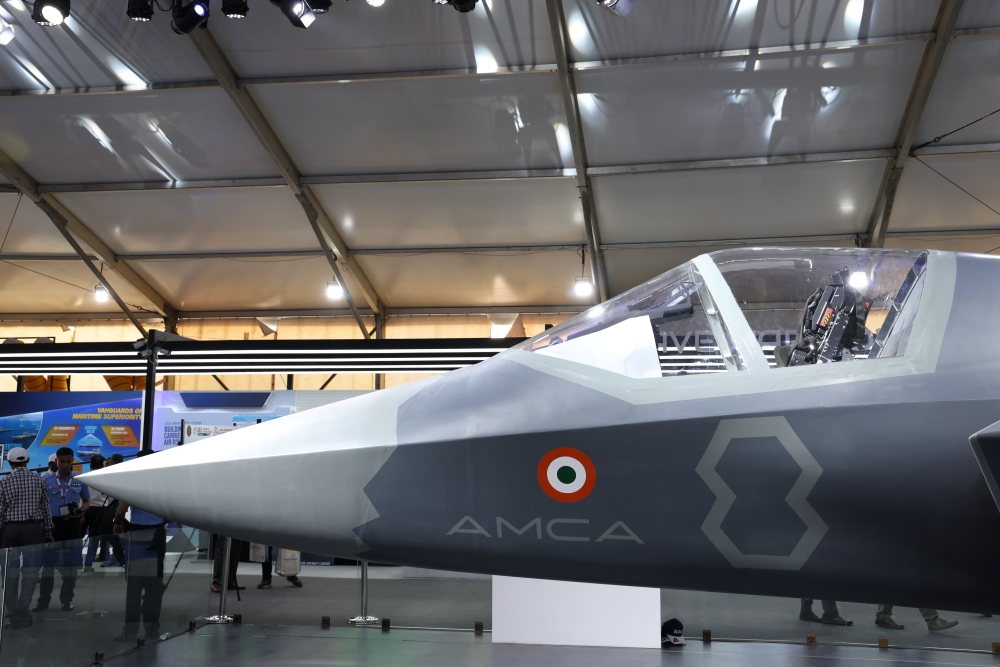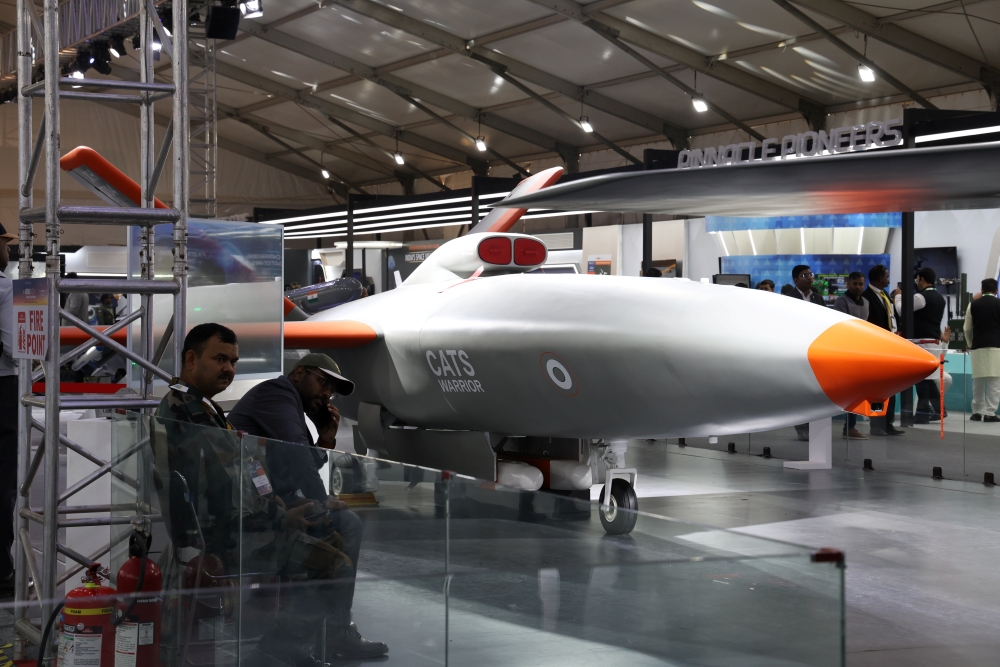
India’s biennial airshow, Aero India showcased the subcontinent’s growing aerospace and defence capability, with a wide range of indigenous programmes on display.
India’s Aeronautical Development Agency (ADA), which has completed the design and development of the TEJAS Mk1 and Mk1A light fighters, showcased a full-scale mockup of its Advanced Medium Combat Aircraft (AMCA), which is slated for service entry by 2036. ADA is also involved in the development of the LCA Mk2, which is being designed as a replacement for the Indian Air Force’s (IAF) Sepecat Jaguar, Mig-29 and Mirage 2000s. India’s state-owned airframer Hindustan Aeronautics Limited (HAL) also put up a strong show with flying displays of the Tejas Mk-1A, HTJ 36 ‘Yashas’, Light Utility Helicopter (LUH) and Light Combat Helicopter (LCH).
5th Gen Fly-Off
While India’s indigenous aircraft and helicopter programmes certainly generated a lot of interest, it was the appearance of 2 advanced 5th generation types for the first time in India that stole the show. The US Lockheed Martin F-35 LIGHTNING II and Russian Sukhoi SU-57E both undertook flying displays at the show, with the latter putting up quite a show. Russian officials also told FW MAG that the SU-57E was being offered for license production in India, with significant levels of technology transfer. However, the real twist in the tale was US President Donald Trump’s announcement, during Indian Prime Minister Narendra Modi’s State Visit to the USA, that he would work towards clearing the sale of the F-35 to India.
The potential sale of the F-35 to India is much more than speculation as the IAF, which is now down to approximately 30 fighter squadrons, is faced with the rapid induction of Chinese 5th gen fighter aircraft by the People’s Liberation Army Air Force (PLAAF), with the potential for Pakistan to acquire these types before the end of the decade. New Delhi appears to be continuing with the air force Multi-Role Fighter Aircraft (MRFA) acquisition for 114 aircraft, which is targeting local manufacture of the selected fighter in India, with significant levels of technology transfer.
However, all the aircraft on offer in the MRFA tender are essentially 4.5 generation platforms, and if a contract is concluded within the next 2-3 years, the air force could receive only a couple of squadrons by 2030. As a result, New Delhi can be expected to study the American offer for the F-35 closely and an off-the shelf purchase of 3-4 squadrons of the 5th generation type, could redress the increasing combat asymmetry of the IAF viz-a-viz the PLAAF.
TEJAS Mk-1A/AMCA/LCA AF MK2
Aero India marked the maiden public appearance of the TEJAS Mk1A with four aircraft taking part in the flying display. One of these was a prototype, while the remaining three were series production aircraft. A TEJAS Mk1A on static display, showcased the type’s unique twin-rail launchers with MBDA’s ASRAAM close combat missile, in addition to carrying the domestically developed Astra BVRAAM. HAL is slated to commence deliveries of the TEJAS Mk1A to the air force from August and deliveries are now planned to be concluded by 2029 with state-owned airframer Hindustan Aeronautics targeting a peak production rate of 24 aircraft per month for 2025-26. The air force has ordered 83 Tejas Mk-1A fighter jets with an additional order for 97 in the pipeline and these aircraft are replacements for the IAF’s MiG-21 (retiring from service in 2025) and MiG-27 (phased-out from service in 2018).
The AMCA is an ambitious Indian effort to develop an indigenous 5th gen fighter, but it currently lags two other such types in development globally: the Korea Aerospace Industries (KAI) KF-21 and Turkish Aerospace KAAN. Along with the proposed Twin-Engine Deck Based Fighter (TEDBF), the proposed development cost for both types amounts to US$4 billion. The AMCA is proposed to be powered by 2 engines in the 90 kN class and prototype aircraft will be powered by GE F414 INS-6 engines.
The IAF presently operates 6 foreign-origin combat aircraft types including the French Dassault RAFALE and MIRAGE 2000, Russian Sukhoi SU-30 MKI and MiG-29, MiG-21 followed by the British origin Sepecat JAGUAR strike aircraft and BAE Hawk Mk-132 advanced jet trainer. The LCA AF Mk2 is planned as a replacement for the air force’s JAGUAR, MiG-29 and MIRAGE 2000s in the next decade. The AMCA will complement air force RAFALE and the selected MRFA type. The 18-tonne class LCA AF Mk2 will be powered by a single GE F414 INS-6 engine. Hindustan Aeronautics is currently in talks with GE to resolve the technology transfer related aspects of the deal, which will see the engines manufactured in India by HAL.
The LCA AF Mk2 will have 11 weapons stations (8 wing stations, two under-engine stations and one centre-line station) and the capability to carry heavy stand-off weapons such as MBDA’s SCALP. All of these Indian fighter types will feature indigenously developed Fly-by-Wire (FBW) systems, Mission Computers, AESA radars, EW and air-to-air and air-to-ground weapons.

CATS WARRIOR Protype
What appears to be a key component of India’s future combat air power is Hindustan Aeronautics’ autonomous Combat Air Teaming System (CATS) programme. HAL successfully performed the first engine ground run for a Full-Scale CATS – WARRIOR Demonstrator, this January and also displayed a full-scale mockup at the show. The unmanned drone is powered by HAL’s indigenously developed PTAE-7 engine and features a domestically developed Mission Computer. The state-owned airframer said that it was targeting the maiden flight of the CATS – WARRIOR by the end of the year.
The deep penetration strike unmanned air vehicle will be operated by a manned fighter aircraft, either the LCA AF MK2 or AMCA and will have a design operational radius of 350 km. It will feature an internal weapons bay, which can carry two domestically developed Smart Anti Airfield Weapon (SAAW) precision munitions, in addition to being equipped with MBDA ASRAAM close combat missiles on its wing stations.
Concluding remarks
India is at an inflection point regarding its combat air programmes, however, endemic design and development delays have resulted in the air force now facing a severe technology asymmetry viz-a-vis the PLAAF. While India will continue to fund its combat air programmes, the procurement of an imported 4.5 generation or 5th generation type, appears on the cards to redress the balance of power in the region.
Follow us on Telegram, Facebook and X.









.png)
